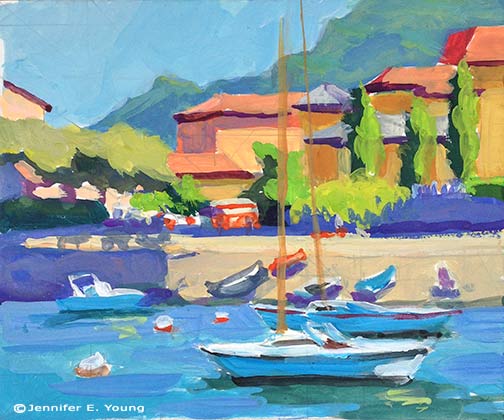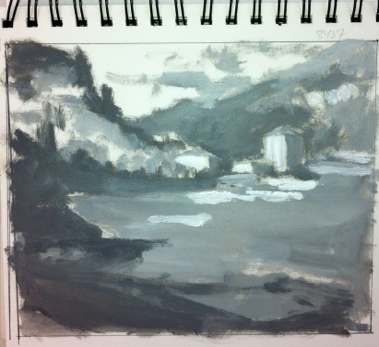Had a few technical difficulties to overcome before I could post again, but I'm picking up where I last left off writing about the Annapolis paint out. Day two of the paint-out started off great, mainly because I had been able to do a little planning the day before. Painting in an unfamiliar place can always be a little overwhelming. It takes a little bit of time to get your bearings and find locations that appeal to you. This task can also be a little more daunting if you are also painting unfamiliar subject matter. (In my case, not living near a harbor or having much boating experience,  that subject matter would be the preponderance of boats.)
To tackle the first obstacle, I spent some time on the first day (in between my morning and afternoon paintings) just wandering around scouting out possible painting locations along the many small harbors. One thing to consider is the path the sun will take across the sky throughout the day from sunrise to sunset. Having already done one morning painting the first day, I began to get a feel for which locations would make good morning setups and which would work better for me in the evenings. (I will also sometimes carry a compass with me to accomplish this task.)Â As a result, I found a location in Eastport that I knew would be perfect for an early morning sunrise scene. And in contrast to the first morning when I got started late, I was able to arrive early on day 2 and start painting between 7 and 7:30 a.m.
As for the second obstacle.... the first thing I had to do was to recognize that no matter what I am painting, all I really need to do is paint shapes and the play of light on forms. If you can accurately see what is in front of you as abstract shapes and light patterns (and get a good grasp especially on painting the shapes of the negative space between the forms as well,) form naturally happens. Having said that, the mind plays tricks on the untrained eye--even sometimes on the eye that has had a bit of training. Boats (like trees and the human face) are some of the things that the mind has long tended to see as symbols. They're some of the things that so many of us drew when we were kids --a sort of half-circle topped with two triangles. So one can easily fall into the trap of painting a symbol of a boat (or a tree or a face) instead of painting the actual shape.
While intellectually I know that all of the above is true, for my own peace of mind, I found it also helpful to consult one of my favorite art books of all time by Emile A. Gruppe. Gruppe was a fine New England painter of landscapes, townscapes and most notably to me, marinescapes . He was active in the 30's on up until the 70's and received training at the Art Students League in New York, and from famed American landscape painters Charles Hawthorne and John F. Carlson
and John F. Carlson . Gruppe was also a wonderful teacher in his own right, both through the school that he established, and through his series of books on painting ("Brushwork
. Gruppe was also a wonderful teacher in his own right, both through the school that he established, and through his series of books on painting ("Brushwork ," "Gruppe on Color
," "Gruppe on Color " and "Gruppe on Painting; Direct Techniques in Oil" ).  Â
" and "Gruppe on Painting; Direct Techniques in Oil" ).  Â
All three of these books are fabulous. They are also out of print, making the ones that are still available quite pricey and difficult to acquire. I haven't written much about these books before because there is just sooo much I would want to to say. I can't give proper honor to each of them now without making this post even longer than it already is, but suffice it to say that despite the cost and the regardless of sad quality of the painting reproductions within, they are three incredibly worthwhile and inspiring (if not essential) additions to any landscape painter's library.
For my money, Gruppe was a master of brushwork and composition. Living in New England, he was also a frequent painter of harbors and coastal scenes, which made his book, "Gruppe on Painting; Direct Techniques in Oil ," a perfect traveling companion on my trip to Annapolis. I'm glad I grabbed it as I was walking out the door, especially since this particular book has a whole section on painting harbor scenes. This is not a book of formulas, but rather a thoughtful book with a wealth of things to consider. For instance, here is an excerpt on drawing boats:
," a perfect traveling companion on my trip to Annapolis. I'm glad I grabbed it as I was walking out the door, especially since this particular book has a whole section on painting harbor scenes. This is not a book of formulas, but rather a thoughtful book with a wealth of things to consider. For instance, here is an excerpt on drawing boats:
"...students have preconceptions about what a boat should look like. They think of boats they drew as children, boats that were shaped like wooden shoes or bananas, curling up at the bow and stern. And that's how they draw them. But probably no shape could be less like that of a real ocean-going dragger; all those concave lines suggest weakness while the character of the dragger is strong and tough......Remember that the gunwhale of the boat is straight as it nears the bow--it doesn't sweep up like a gondola! And the bow goes into the water in a fairly straight line--it doesn't cut under sharply. Use strong lines to suggest a strong subject."
Just that one snippet helped me immensely, and yet there is so much more in this section alone; on cast shadows, masts, rigging, refraction, smaller boats, and docks and wharves. The conversational tone and the passion in Gruppe's writing helped me to internalize his teachings and carry them with me as I addressed the subjects and painted them from life. Here, finally, is the painting that resulted. I may need to touch it up when I return to the studio, but I was pretty happy about it overall:
 Â
Â
Daybreak in Annapolis
Oil on Multimedia Artboard, 11x14"

On this second day of painting, I was happy to meet more of the artist members of the MAPAPA, so I felt a little more connected and a little less lost. In fact, as I was finishing up the above piece, an artist came up to me with a rather dazed and confused look. She said it was her first day at the paint-out, and she'd been driving around for an hour trying to decide what to paint. I had to chuckle (not at her, but with her.) Been there, done that!
 Colors of Varenna (study)
Gouache on Cottonwood Arts Coldpress paper, 5x6"
Colors of Varenna (study)
Gouache on Cottonwood Arts Coldpress paper, 5x6"










 andÂ
and  Â
 
 I brought a 5x8" moleskine journal with me, which fit nicely into my carryall bag. Never one to be without as many options as possible, I chose the notebook that would accept watercolors (though most of my sketches were pen and ink.) Here's one with my notes of
I brought a 5x8" moleskine journal with me, which fit nicely into my carryall bag. Never one to be without as many options as possible, I chose the notebook that would accept watercolors (though most of my sketches were pen and ink.) Here's one with my notes of 


 Â
 












